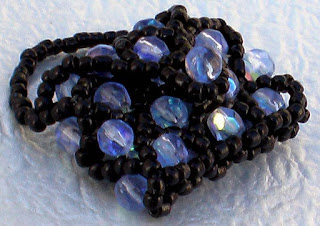Basic Jewellery Making
This basic jewellery making article is a wonderful place to begin to learn all about the art of working with beads. It explains types of beading, and tools needed, perfect for a beginner.
Types of Basic Jewellery Making
 |
| Beaded Reindeer |
Stringing: beads of all sorts of types and colours are strung onto a beading thread using pleasing designs and colours.
Beadweaving: this is sometimes known as seed beading. This includes a wide variety of weaves, including herringbone weave, brick stitch, peyote, netting, pondo stitch, right angle weave and square stitch. With the exception of two-needle right angle weave, these all require a needle and thread, and you weave in a similar way to sewing. Two needle right angle weave is usually not done with needles at all, a stiff thread is used, and the beads can be strung onto it without the use of a needle. There are also a huge range of spirals that can be made in all of the above weaves, as well as a few particular to spirals only. These include: Spiral rope, double spiral rope, triple spiral rope, flat spiral, Russian spiral, Dutch spiral, herringbone spiral, embellished right angle weave, Cellini spiral, Aussie spiral, netted spiral and African Helix.
 |
| Bugle spiral |
Loom Beading: seed beads are woven into fabric using a loom. Some very intricate designs can be made.
Wire work and wire wrapping: This is where wire is used to created pleasing shapes and designs using wire.
 |
| wire work jewellery |
Victorian Beading and French Beading: these methods ore often used to make beaded flowers. Wire is used, as well as seed beads. Victorian beading, also known as Continental Beading, is worked horizontally with both ends of the wire going through the row of beads. French beading is worked vertically with rows of beads worked around a central row of beads.
 |
| Victorian beaded spider |
Chainmail: also known as chain maille. This is created by joining jump rings into intricate patterns.
 |
| Chainmail |
What is a Bead?
Basic jewellery making usually includes beads. Basically a bead is a small decorative object that has at least one hole in it for threading. Beads have been used for jewellery for hundreds of thousands of years.
 |
| Beaded Bead |
Beads can be made from all sorts of things, including: natural materials- such as bone, coral, seashells and nuts. They can also be made of synthetic materials such as: ceramics, glass, crystal and plastic.
Bead Types
Seed Beads: seed beads are the very tiny beads used in basic jewellery making and beadweaving. These are usually measured in either mm or aught sizes, eg. 11/0, which means number of beads per inch.
There are three main types of seed beads available:
* Japanese: these have a cylindrical shape and are very uniform in size. They have a large hole.
* Czech: these have more of a rounded shape with smooth edges. They’re sometimes described as being donut shaped.
* Chinese: these are the cheapest type of seed beads, but can be very uneven in shape and size. They are usually more Czech-shaped.
 |
| Beaded Brooch |
Bugle beads: these are long cylindrical beads, made in a range of lengths.
Shaped beads: these are made in any sorts of shapes.
Faceted beads: these have been cut and polished to give lots of reflection and shine.
Tools and Materials Required for Basic Jewellery Making
The tools needed for basic jewellery making vary with what is being made and the technique used.
Some basic tools and materials are:
Thread: some available types are: tigertail, aculon, monofilament thread and Nymo.
Crimp beads: these are small soft metal beads with a large hole that are used to squash the thread together to hold the finding in place.
Findings: these are all the components used in basic jewellery making to make things into jewellery, includes clasps, earring hooks and key rings.
Pliers: these are need for many things in basic jewellery making, including closing crimp beads. Two are usually needed to close jump rings.
 |
| Flower Brooch |
Specific tools and materials:
Stringing: generally you don’t need much at all. Just your beads and thread, you’ll also need a couple of crimp beads and a couple of jump rings. You’ll need pliers to close the crimp beads and jump rings. You’ll also need clasps or other findings for your basic jewellery making, depending on what you’re making,
Beadweaving: For this you’ll need fine thread, beading needle, seed beads. You’ll also need the crimp beads and other findings the same as with stringing, depending on what you’re making.
Loom Beading: loom, thread and seed beads, and findings as required.
Wire work and wire wrapping: The wire can be craft wire, artistic wire, copper wire, or sterling silver wire. They are available in different gauges that measure the thicknesses. You will need pointy nosed pliers, and round nosed pliers to create spirals and loops. Wire cutters are required to cut the wire.
 |
| Saint Bernard |
Victorian Beading and French Beading: Seed beads and wire are required for these. Pointy nosed pliers will be needed. If it’s going to be a flower, you’ll need a stiffer wire for the stem and some floral tape to wrap it.
Chainmail: This just requires lots of jump ring available in different sizes and gauges, as well as 2 pairs of pliers to close the rings. You’ll also need the findings as required.
 |
| Chainmail earrings |
A good beginners tutorial can be found here:
http://craftcove.blogspot.com/2009/04/free-star-tutorial.html























